|
Sherrill
Research Corporation in World War Two
Peru, IN
1938-1953
Sherrill Corporation
Mexico, IN
1953-1996
This page updated 3-1-2025.
The Sherrill
Research Corporation was founded in 1938 by Burl Sherrill (1901-1979) in
Peru, IN. Throughout its existence, it remained a family business.
Burl brought his father Calvin Sherrill (1876-1945) in as head of
Sherrill Research Corporation and production supervisor at the Sherrill
plant until his death in 1945.
In 1953 the Sherrill
Research Corporation moved several miles north of Peru, IN to Mexico,
IN. At the same time, it was renamed the Sherrill Corporation.
The company operated in Mexico, IN until 1996 when it was sold to the
Custom Accessories, Inc. in Chicago, IL. The Mexico, IN plant
continued to make compasses until 1998, when the operation was moved to
Chicago. At some later date, Custom Accessories moved the
manufacturing to China.
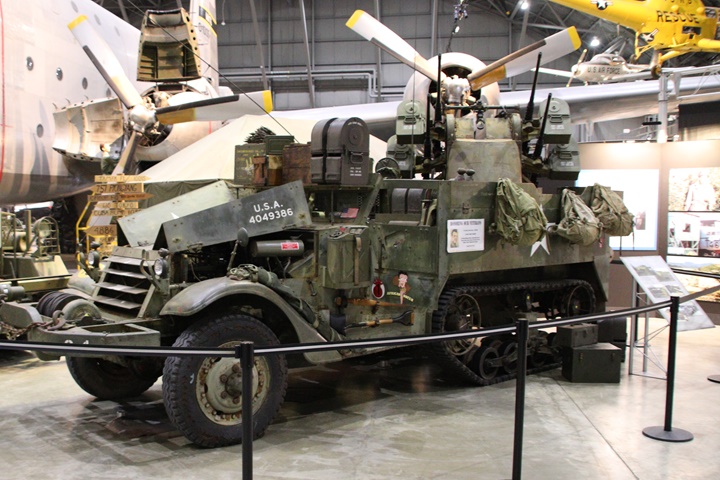
I never intended to do a webpage on the Sherrill Research Corporation.
I didn't even know it existed. In late December 2020, I made a
trip to the National Museum of the United States Air Force and found
this half-track on temporary display. In the many years I have
visited the museum, this is the first time there was a World
War Two vehicle on special display. I spent considerable time
photographing all of the details. Author's photo.
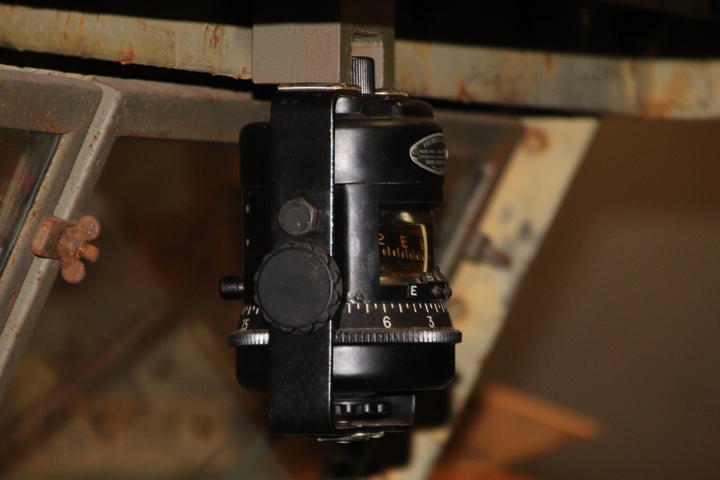
Upon returning home, I went through my
photos and noted that I might be able to obtain some information about
the compass manufacturer. Author's photo.
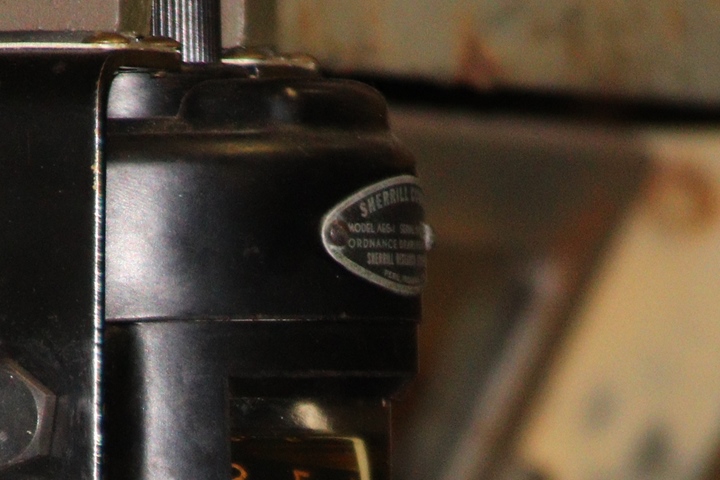
Enlarging the photo, I could
see that this was a Model AEG-1 built by Sherrill in Peru, IN.
This immediately piqued my interest because I only live seventy miles
from Peru. A quick internet search provided some sketchy
information on the Sherrill Research Corporation. I wanted to
learn more and decided to see if there was enough information to do a
web page on the company. Author's photo.
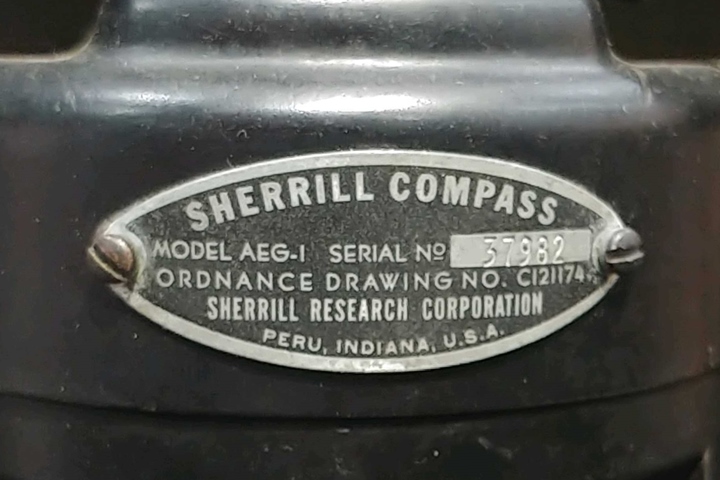
This photo of the serial number was provided
by the owner of the half-track African Queen. It is serial number
37982. Photo courtesy of Mark Koloc added 3-15-2021.
The Miami County Historical Society in Peru,
IN provided much of the information that allowed me to get a close look
at the Sherrill Research Corporation during World War Two. The
staff was extremely helpful in finding documents and newspaper clippings
that provide much of the historical content of this page. There
were several folders with newspaper clippings, photos, and related
information on the company. In what is normally the reverse of
information found at historical centers and libraries, most of the
information on Sherrill was about the company during World War Two.
The historical center also has several World War Two Sherrill compasses
in its collection. I was able to study these in detail.
The Historical Center also includes three
floors of museum displays. It is well worth the visit when in the
area. World War Two era photos on this page are courtesy
of the Miami County Historical Society.
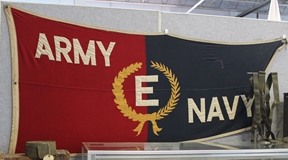
The Sherrill Research Corporation won the Army-Navy "E"
award two times.
The Sherrill Research Corporation won the first Army-Navy "E" Award on January
12, 1945.
It won its second Award on July 11, 1945.
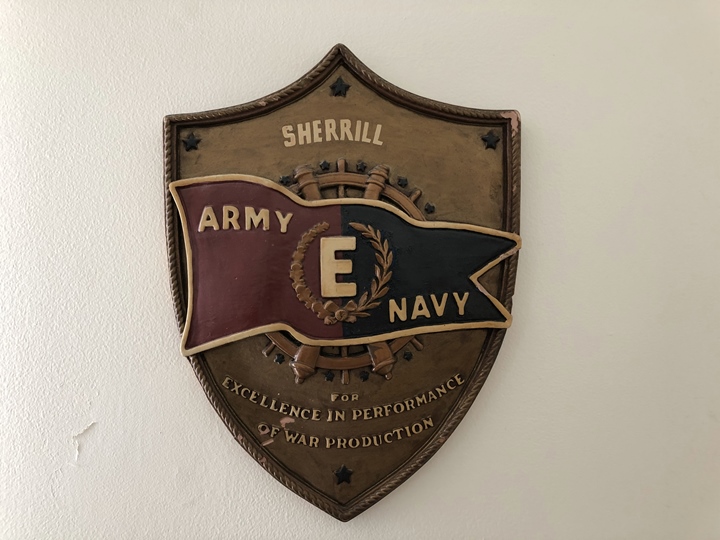
The Sherrill Research Corporation also
received this Army-Navy "E" award plaque during World War Two for its
excellent production record. Photo courtesy of Lynette Sherrill
added 2-22-2021.
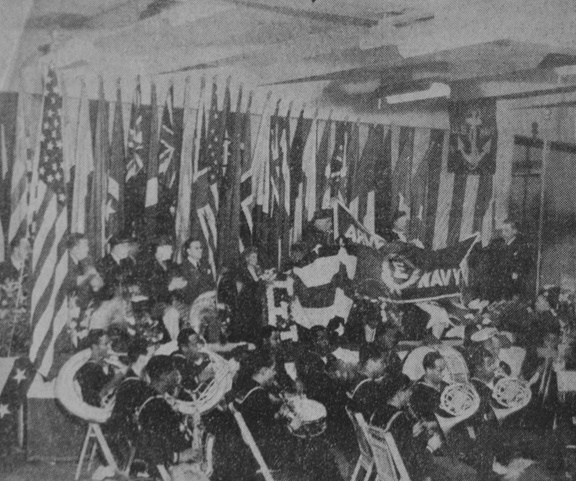
The band from the nearby Bunker Hill Naval
Air Station that played at the first award ceremony consisted of African-American musicians. One of the
great travesties and hypocrisies of the American involvement for the "fight for
freedom" in World War Two was a segregated military. Photo
courtesy of the Miami County Historical Society.
Background: In today's age of
GPS, smart phones, and satellite views of the entire earth, one may
forget these were not available 80 years ago during World War Two.
The U.S. military was operating in places for which it had no maps.
Even during several early 1940's Army maneuvers conducted in the southern U.S., the Army had to rely on road maps found in gas
stations. Overseas, it was even worse. Many times, the U.S.
military had to resort to tourist's travel guides to try and navigate
the battlefields.
The soldiers also needed a compass to tell
them which direction they were going. Past wars were not fought
with 30-ton steel tanks that interfered with the operation of the
compasses and provided erroneous readings. Burl Sherrill was
working on compass designs early in World War Two that would provide the
U.S. Army a compass that would work in its steel tanks.
Sherrill Research Corporation is also an
example of thousands of small companies all across the United States in
both small and large cities that provided all of the necessary items to
win World War Two. Many of those companies no longer exist and
have been forgotten. Even if they do exist, their participation in
a war 80 years ago is ancient history and not relevant to current
business problems.
The Sherrill Research Corporation is a unique
opportunity to look at one of these small companies that produced an
important product at the right time during the war. Theirs were
truly high-tech products of their time. All of this work was done
in a three-story office building across from the county courthouse in a
town of 13,000 people at the time. Both structures still exist in
Peru, IN.
Significant Dates:
The following dates and information come from the Peru Republican, the
Peru Tribune, and a
letter to the Miami County Historical Society dated May 18, 1994, by Mr. Colin Sherrill.
1941 - Sherrill Research wins its first
commercial contract with the Marshall Field department store in Chicago, IL
for the "Dollar Compass," which retailed for a one dollar.
Early War Years 1942-1943 - During 1942
through April 1943, Burl Sherrill worked with the Army and Navy on the development of
magnetic compasses. The company
received no government financial assistance to develop compasses that
would work in metal vehicles. This was an important project for
the U.S. Army because metallic vehicles, such as tanks
and half-tracks deployed in North Africa, were getting lost because their compasses were inaccurate due to the
amount of steel in the vehicles. In 1943 Sherrill Research Corporation received its first
military contract. This is very unusual because many companies
started producing for World War Two in 1940. Sherrill only had two
years of military production during the war, but it was important and
critical production for the war effort.
1943 - Burl Sherrill invents both the AEG and
M6 compass. It was unknown by Mr. Colin Sherrill what AEG stood
for.
November 26, 1943 - Sherrill Research Corporation began expanding in the
building it occupied across from the Miami, IN county courthouse.
Expansion on the first floor of the three story office building allowed 10,000
square feet to build compasses for the U.S. Army.
December 31, 1943 - Thirty-six doctors, real
estate brokers, and insurance salesmen had to move out of their offices
on the second and third floors of the Sherrill building.
Originally the factory was two rooms on the first floor of the building.
Ninety employees were working seven days a week on two shifts to produce 300 plastic-bodied compasses per day for Army trucks
and tanks. Each compass cost
$45.
The newspaper article of December 31, 1943, noted the importance of the plastic magnetic compass for
use in tanks. It explained that in the North Africa campaign
American tanks did not have compasses. Without good maps or many
landmarks, several units became lost and captured. German tanks
were equipped with gyro-compasses, which allowed them to properly
navigate the desert. This article was a reprint of an Indianapolis
Star column from December 10, 1943. The Star article mentioned that
Burl Sherrill was in Washington, DC at that time for discussions with
the U.S. Navy about a compass that did not need to be built with
critical materials. This meant that a Sherrill plastic compass was
ideal for the Navy's applications.
Unknown date - Colin Sherrill's letter stated
that there were 150-200 working two shifts.
July 21, 1944 - It was announced
that the company would be building a new compass for the U.S. Navy.
The size of the contract exceeded the size of
the Army contract to date. This was more than double the output of the
operation. This could be the point at which more employees were
needed, and employment went from the original ninety employees to
150-200. The engineering department was also increased in size and
a new chief engineer was hired who previously worked at Bendix.
The U.S. Navy used the M-6 compass during
World War Two and designated it Compass No. 6, Mark 2, Model 0.
The U.S. Navy BUSHIPS manual for the compass acknowledged on the cover
that it was U.S. Army Ordnance M-6.
November 24, 1944. Army trucks and an M8
armored car visited the plant in Peru, IN. All of the vehicles were
equipped with Sherrill compasses.
January 19,1945 - Burl Sherrill was in
Washington, DC and met with the U.S. Navy to discuss a new compass.
No new compass came out of this meeting. Sherrill only built the
AEG/AEG-1 and M-6 during World War Two. Any development work
stopped with the end of the war in August 1945. Sherrill never
built any more compasses for the military. Production after the
war went to the
automobile industry.
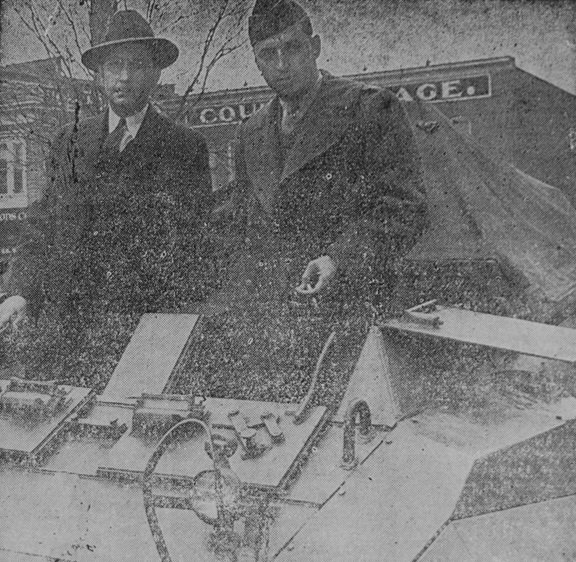
Burl Sherrill, president of Sherrill
Research Corporation, is in a Ford-built M8 on November 24,1944.
Mr. Sherrill was the holder of 27 patents at that time. Photo
courtesy of the Miami County Historical Society.
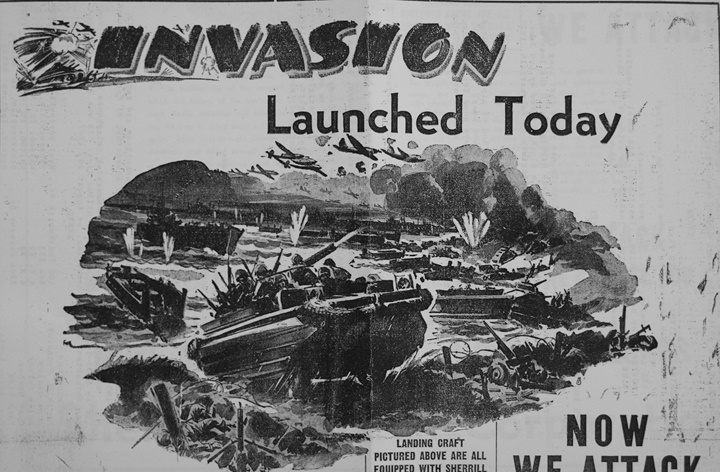
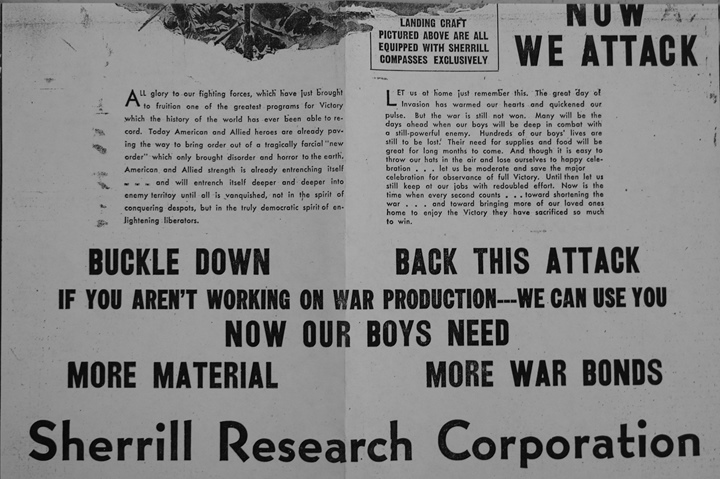
This full page advertisement ran during
June 1944 in the Peru Tribune. It notes that all of the pictured landing craft have Sherrill compasses. The most obvious vehicle is the GMC DUKW.
The rest are rather vague, but one appears to be a Landing Craft, Tank.
Photo courtesy of the Miami County Historical Society.
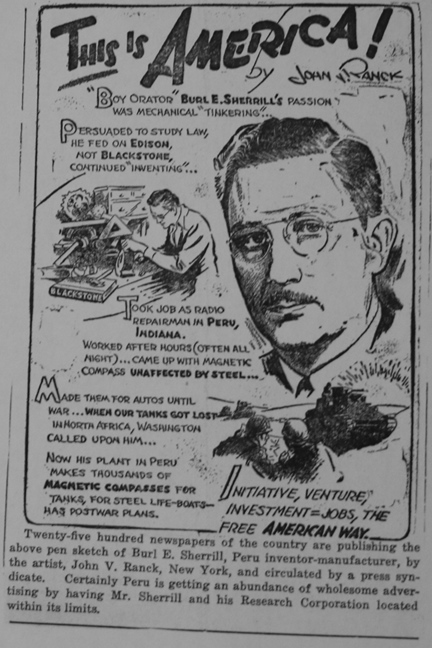
This nationally syndicated short history
appeared in 1945. I remember seeing these in the newspaper when
growing up. They were cool short informationals. Photo
courtesy of the Miami County Historical Society.
Sherrill Research Corporation
World War Two Products: Table 1 shows that Sherrill Research
had $1,481,000 in major contracts from three different customers, with
Army Ordnance being the largest with $1,013,000 for M6 compasses.
This was 68% of the total major contracts. The U.S. Navy was next
with a $$297,000 order that was 20% of the contracts. The War
Shipping Administration ordered $171,000 worth of mariners compasses,
which were 12% of the contracts. Table 1 is important. This
is because all of the research information presented below is for
compasses for use by the U.S. Army. Table 1 indicates that
Sherrill Research Corporation also provided compasses for use on ships
by the U.S. Navy and non-military cargo ships.
The company built at least 125,175 AEG, AEG-1, and
M-6 compasses. These were the only products built during World War
Two. One historical source indicates that Sherrill had a run rate
of 300 units per day in December 1943. This is 9,000 per month or
109,500 per year. From December 1943 until August 1945, when the
war ended, Sherrill could have produced 189,000 compasses. The
highest serial number found on e-commerce sales websites for an AEG-1
is 45385. The only AEG found online had an illegible serial number.
The highest serial number for the M-6 is 89,789. Adding these
three together indicates Sherrill built at least 125,175 units.
Therefore, the theoretical production number of 189,000 units is
possible. Probably, once the supply pipeline became filled and the
necessary vehicles equipped with the compasses, the military would have
cut back on production.
Assuming the serial numbers found are close to
the maximum number of AEG-1 and M-6 compasses built, 36% were AEG-1s and
64% were M-6s. With no serial number for the one AEG found, no
estimation of it can be made. However, it appears to have had a
short production run that was quickly superseded by the AEG-1. The
AEG/AEG-1 was the larger, more complicated, and more costly of the two
compasses. It would only be used where necessary.
Table 1 - Sherrill Research Corporation's
Major World War
Two Contracts
The information below comes from the "Alphabetical Listing
of Major War Supply Contracts, June 1940 through September
1945." This was published by the Civilian Production
Administration, Industrial Statistics Division, Requirements
and Progress Branch January 21, 1946. |
|
Product - Customer |
Contract Number |
Contract Amount |
Award Date |
Completion
Date |
| Vehicular
Compasses M6 - Army Ordnance |
11022-ORD-2327 |
$1,013,000 |
3-1944 |
8-1944 |
| Compasses -
Navy |
XSS-73355 |
$297,000 |
8-1944 |
5-1945 |
| Mariners
Compasses - War Shipping Administration |
WSA-9254 |
$171,000 |
3-1945 |
8-1945 |
| Total |
|
$1,481,000 |
|
|
AEG and AEG-1- These were designed to
be used on tanks, tank destroyers, and other heavily armored vehicles.
These are specifically called out by Mr. Colin Sherrill's letter dated May
18, 1994.
M-6 - This was designed for light armor
such as half-tracks, amphibious vehicles, and landing craft. These
are specifically called out by Mr. Colin Sherrill's letter dated May
18, 1994.
As of November 1944, Sherrill compasses were
standard on sixteen steel vehicles. This was noted when
an army convoy of trucks equipped with Sherrill compasses arrived in Peru. An M8
armored car which had a Sherrill compass was also in the convoy.
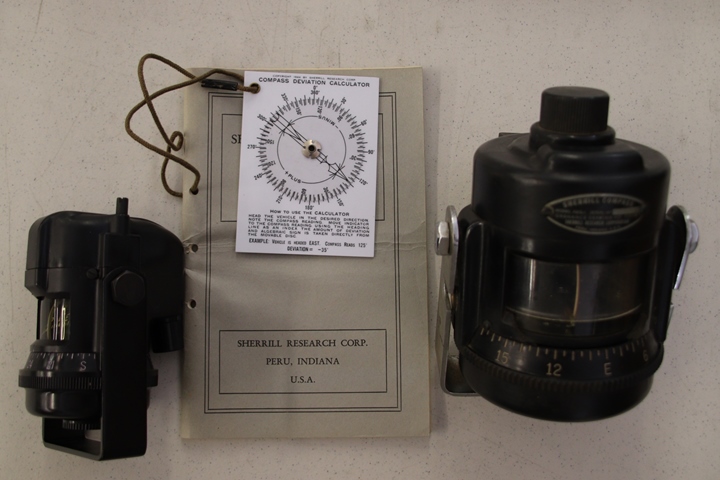
The Sherrill M-6 is to the left of the manual and the AEG-1 is to the
right. The AEG-1 is about twice the size of the M-6. The
manual is 8.75 inches tall by 6 inches wide for a relative comparison of
size. Both compasses were made out of plastic, which at this time was most likely a thermoset molding compound. The most well-known of
these is Bakelite. Author's photo at the Miami County Historical
Society.
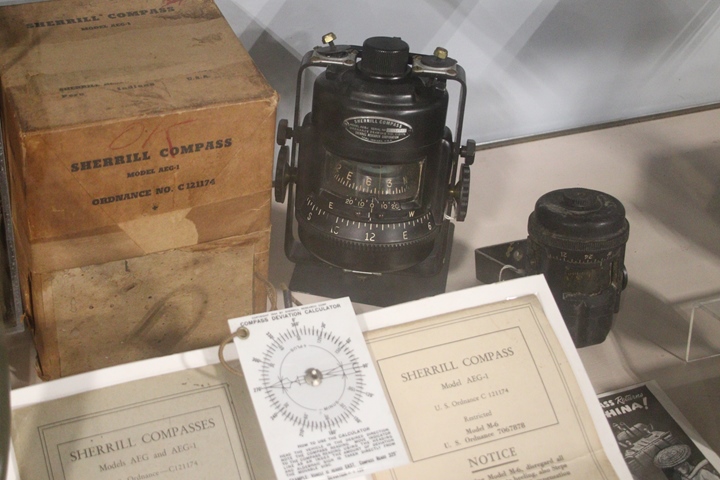
This Sherrill Research Corporation display is located at the Museum of
the Soldier in Portland, IN. It includes both the AEG-1 and M-6
compasses. The AEG-1 is serial number 44797 and the M-6 is serial
number 70216. Author's photo
added 5-5-2021.
Sherrill Research Corporation Compass Usage in World War
Two
Based on information contained in the historical record,
this is my best estimate of which vehicles used which type
of Sherill compass. |
|
Vehicle |
AEG/AEG-1 |
M-6 |
Comments |
|
Heavy Steel Armored Vehicles |
|
|
|
|
M4 Series Medium Tanks |
x |
|
|
|
M26 Heavy Tank |
x |
|
|
|
M24 Light Tank |
x |
|
|
|
M5 Series Medium Tanks |
x |
|
|
|
M8 75mm Gun Motor Carriage |
x |
|
|
|
M10 Tank Destroyer |
x |
|
|
|
M36 Tank Destroyer |
x |
|
|
| |
|
|
|
|
Light Steel Armored Vehicles |
|
|
|
|
Half-Tracks |
|
x |
The one example of a half-track I have found, as shown
above, has an AEG-1 installed.
|
|
M8 Armored Car |
|
x |
|
|
M20 Armored Car |
|
x |
A
restoration of an M20 to replicate General Patton's M20
Command Car in Europe has an AEG-1 installed. |
|
M7 105mm Gun Motor Carriage |
|
x |
|
|
M4 High Speed Tractor |
|
x |
|
|
M5 High Speed Tractor |
|
x |
|
|
M6 High Speed Tractor |
|
x |
|
|
M12 155mm Gun Motor Carriage |
|
|
|
| |
|
|
|
|
Non-Armored Vehicles |
|
|
|
|
DUKW |
|
x |
|
|
Various Tactical Trucks |
|
x |
|
| |
|
|
|
|
Landing Craft |
|
|
|
|
LCVP |
|
x |
|
|
LCM |
|
x |
|
|
LCT |
|
x |
|
AEG-1 Photos:
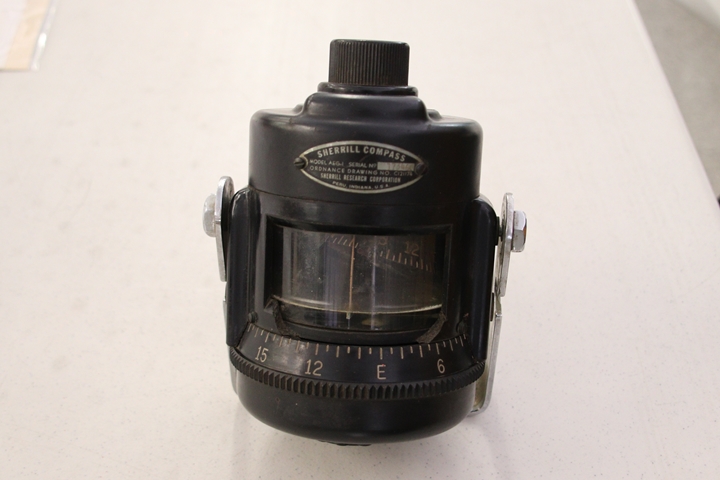
Author's photo at the Miami County
Historical Society.
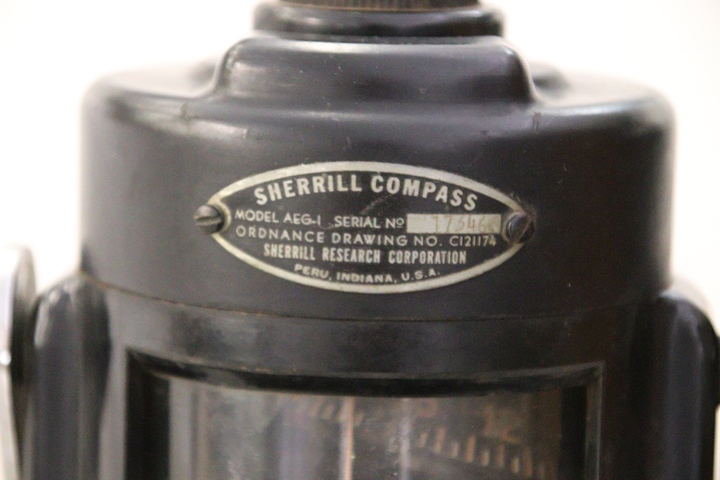
Author's photo at the Miami County
Historical Society.
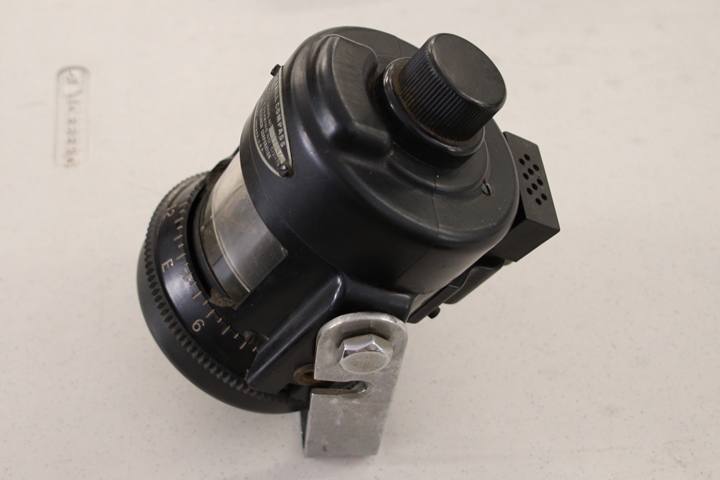
Author's photo at the Miami County
Historical Society.
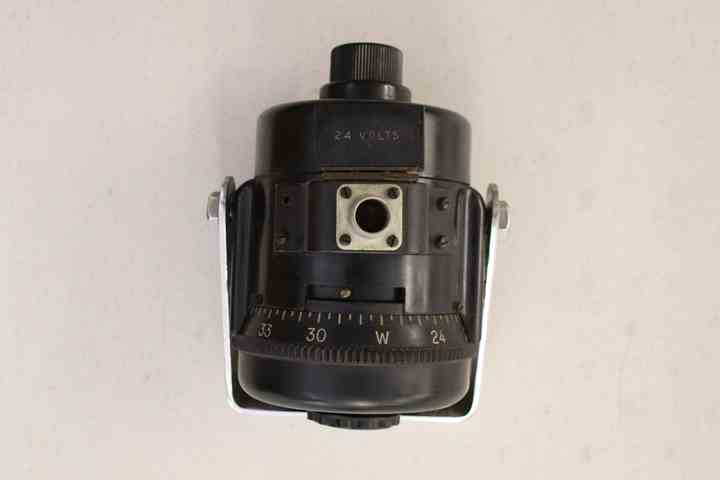
Author's photo at the Miami County
Historical Society.
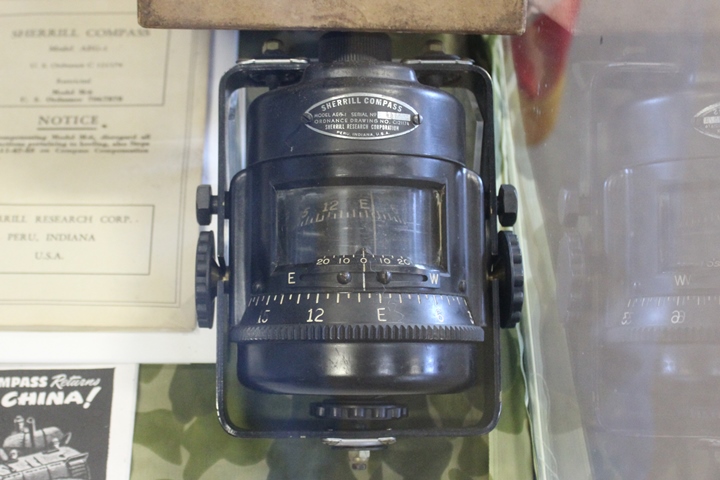
Here is another photo of the AEG-1 at the
Museum of the Soldier. This photo was taken during an earlier
visit. Author's photo added 2-7-2022.
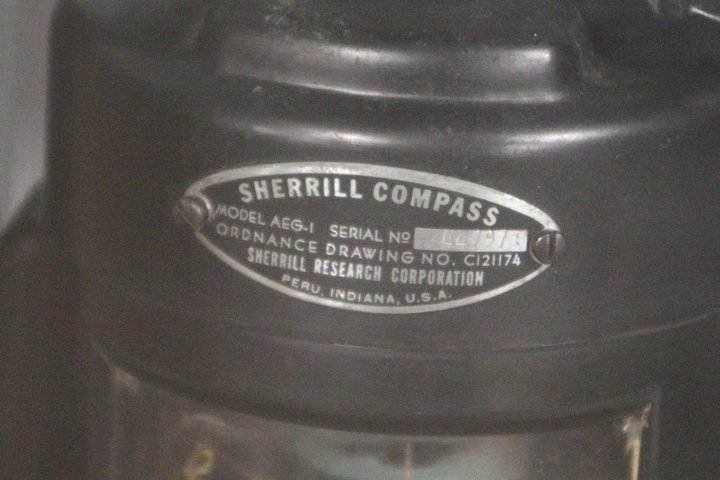
This shows the serial number 44797.
Author's photo added 2-7-2022.
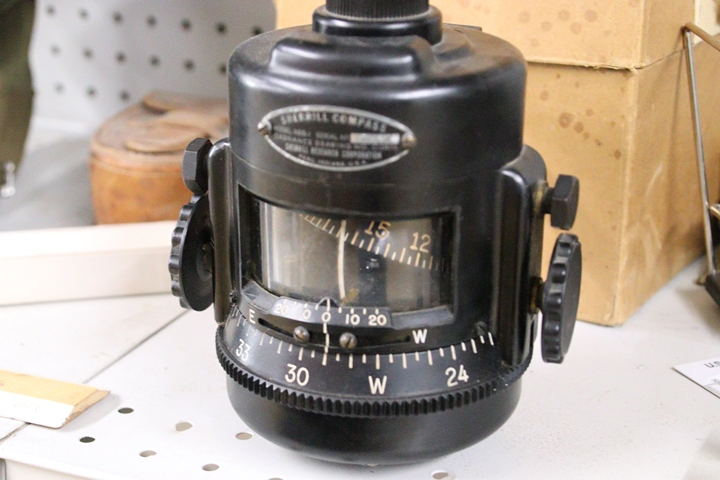
This AEG-1 is on display at the Heartland
Military Museum in Lexington, NE. Author's photo added 3-1-2025.

Author's photo added 3-1-2025.
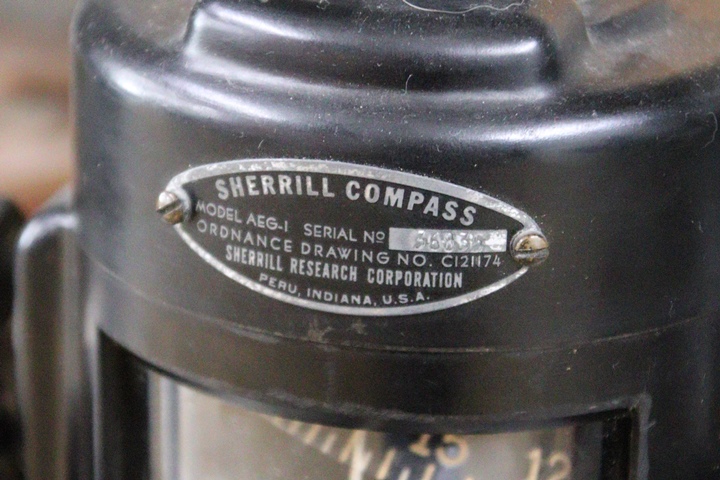
This is AEG-1 serial number 36835.
Author's photo added 3-1-2025.
M-6 Photos:
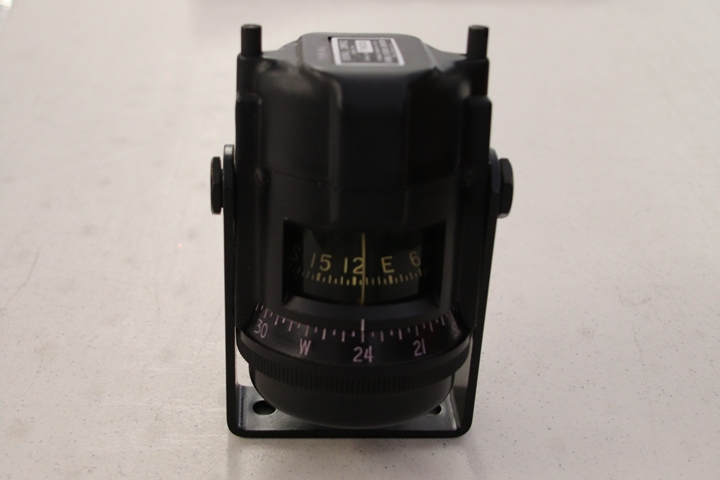
Author's photo at the Miami County
Historical Society.
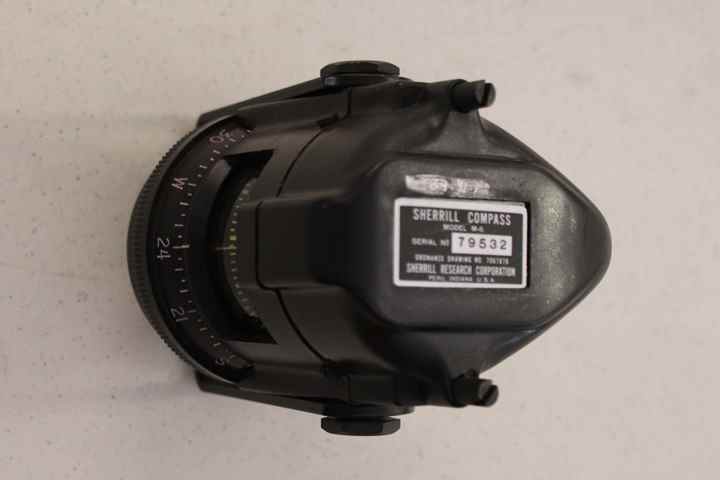
Author's photo at the Miami County
Historical Society.
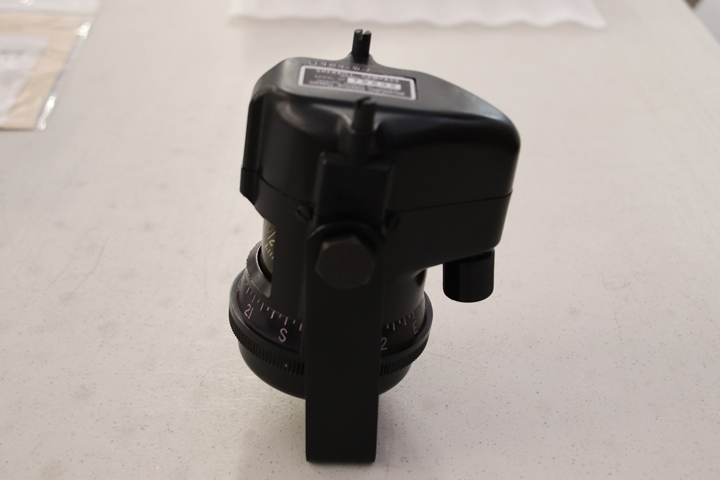
Author's photo at the Miami County
Historical Society.
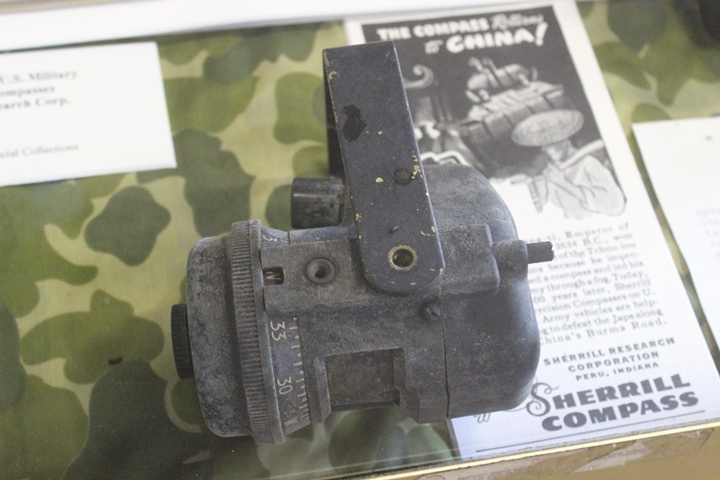
This photo of the M-6 at the Museum of the
Soldier in Portland, IN was also taken at a earlier date. Author's
photo added 2-7-2022.
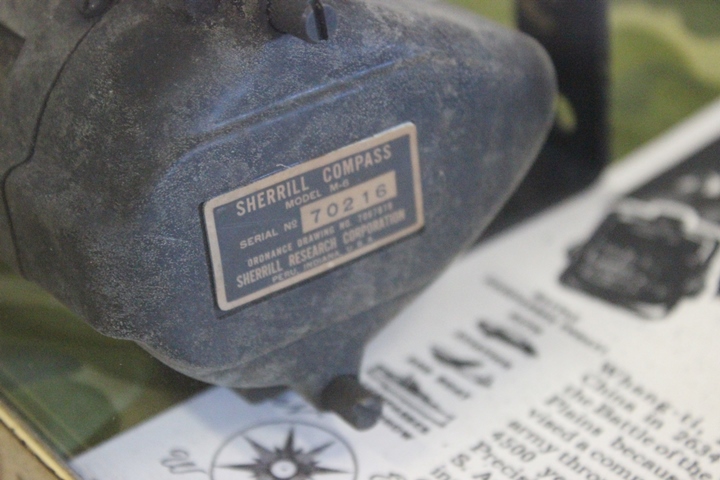
This Sherrill M-6 is serial number 70216.
Author's photo added 2-7-2022.
The Plants:
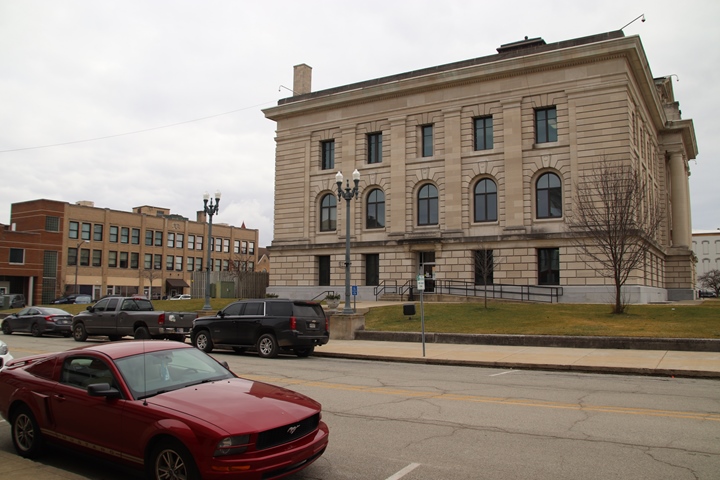
The photo shows the Peru, IN county
courthouse with the
former Sherrill Building behind it. The Sherrill Building is east of the courthouse. The photo was
taken from in front of the Miami County Historical Society. Author's
photo.
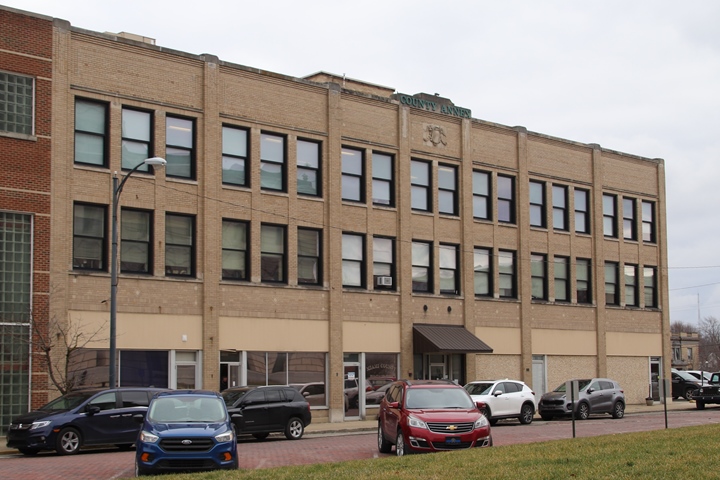
All of the AEG/AEG-1 and M-6 compasses were
built in this three story office building during World War Two.
Occupants of thirty-six offices on the second and third floors had been
relocated to other locations. Then all of the walls were removed to
provide open manufacturing and assembly areas. There is no
evidence that the Peru Republican moved out of its offices on the south
end of the first floor. The Sherrill Building is now the Miami County
Annex. Author's photo.
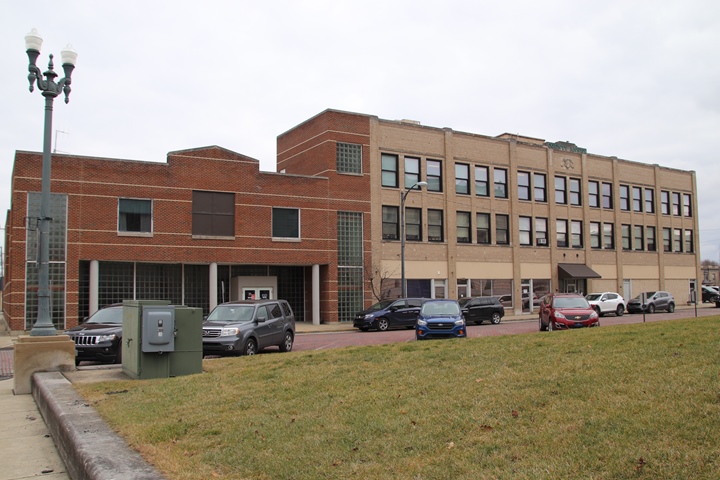
The photo below shows there was another
building to the north of the Sherrill building during World War Two. An
alley separated the two structures. The current red brick building
is of recent construction. Author's photo.
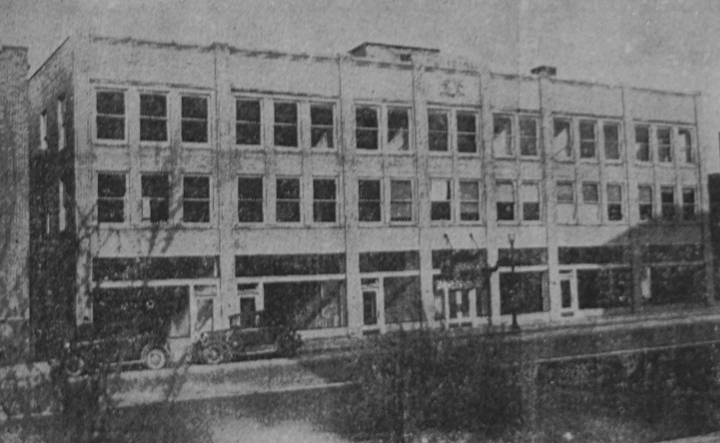
In November 1943 Sherrill Research
Laboratories added 10,000 square feet of factory space in what was a
parking garage in this building. In December 1943 the second and
third floors were cleared out. The Peru Republican was also in
this building and was on the right side of the photo. This was the
south end of the building. Photo courtesy of the Miami County
Historical Society.
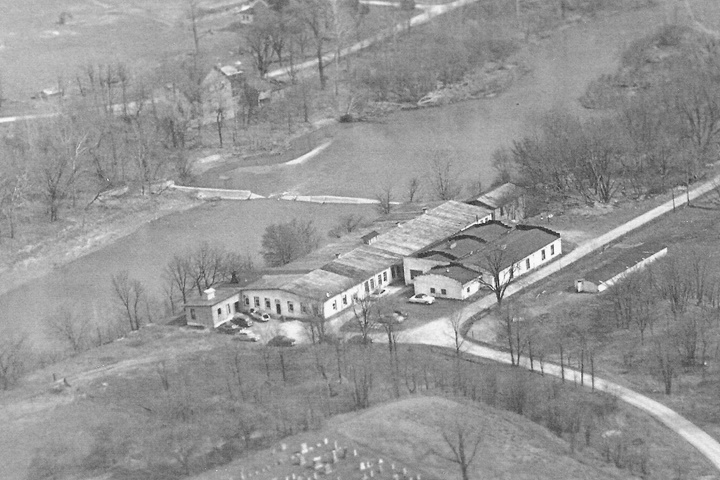
In 1953 Sherrill moved out of the Sherrill
building across from the courthouse in Peru, IN to this facility along
the Eel River in Mexico, IN.
Reasons for the move are unknown. It could be that this offered more or
equivalent space at a lower cost. This building served as both headquarters and
manufacturing operations for automobile compasses. From the vintage of the vehicles parked around the building, this
appears to be the 1950's. Previously, the facility was the location of
Mexico Woolen Mills. The Indiana Department of Natural Resources
removed the dam in 2018. Photo courtesy of the Miami County
Historical Society.
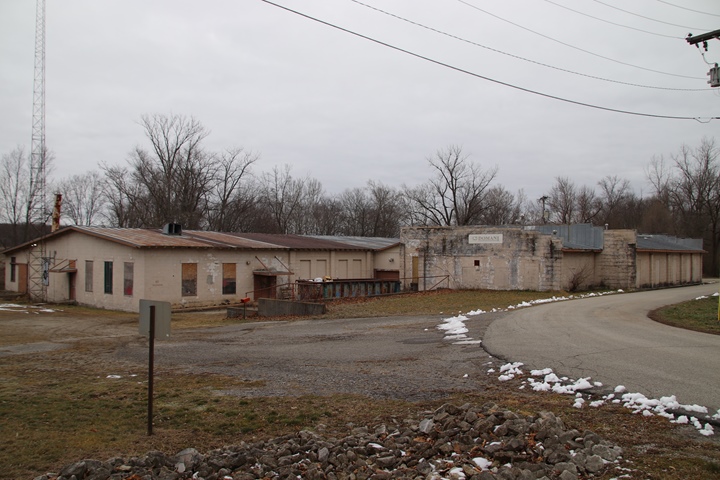
The former Sherrill plant in Mexico,
IN still exists. In 1998, this facility closed, and production
moved to Chicago, IL. Later, production moved to China where Sherrill name-plated digital
compasses were built. The two smaller buildings shown in the aerial
photo have been removed. Author's photo.
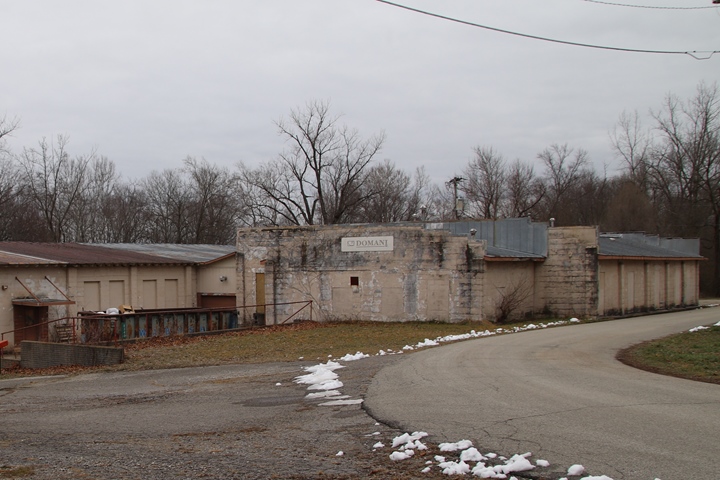
The markings on the wall, where a building
used to be, are evident under the Domani sign. Author's photo.
Armored Vehicles with Sherrill Research
Corporation Compasses: Sherrill did not begin to produce
compasses until November 1943. By then, the battles for North
Africa and Sicily were over. Italy was invaded in September 1943,
and that campaign would grind on until the end of the war. It was
going to take time for the production of the Sherrill compasses to start reaching
supply depots in Europe for distribution to units already in or
preparing for combat. Most compasses went to England for installation
in equipment being prepared for the invasion of Europe. The
upcoming invasion of Europe had top priority for men and equipment.
Most likely, Sherrill Gyrocompasses did not
enter combat until June 6, 1944, during the invasion at Normandy.
Up until then, most of the pieces of equipment operated without them.
AEG/AEG-1:
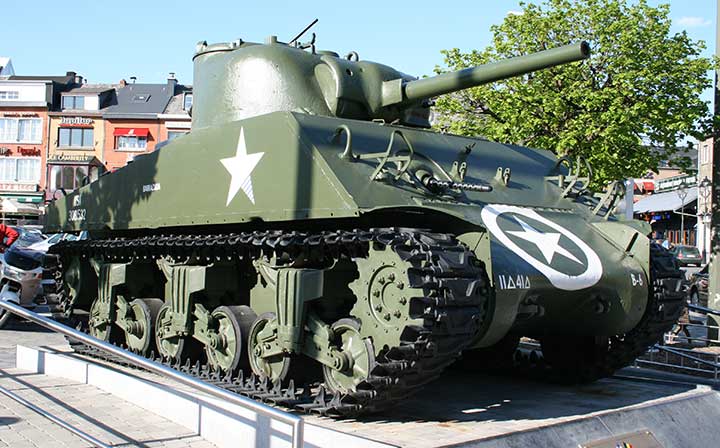
This
Fisher Body Grand Blanc Tank Arsenal-built M4A3 Sherman tank combat
veteran is on display in downtown Bastogne, Belgium. It was knocked
out of combat during one of the most famous battles of World War Two,
the Battle of the Bulge, on December 30, 1944. The tank was
attached to B Company, 41st
Tank Battalion, 11th Armored Division when it was put out of action near Renuamont, Belgium. It had been named "Barracuda" by its crew.
It
sits at the intersection of several roads in Bastogne that made the town
an important military objective during the battle. This Sherman
tank would have been equipped with a Sherrill Research Corporation compass
during the Battle of the Bulge. The compass would have been
invaluable in correctly navigating the fields and wooded areas around
Bastogne.
Author's photo.
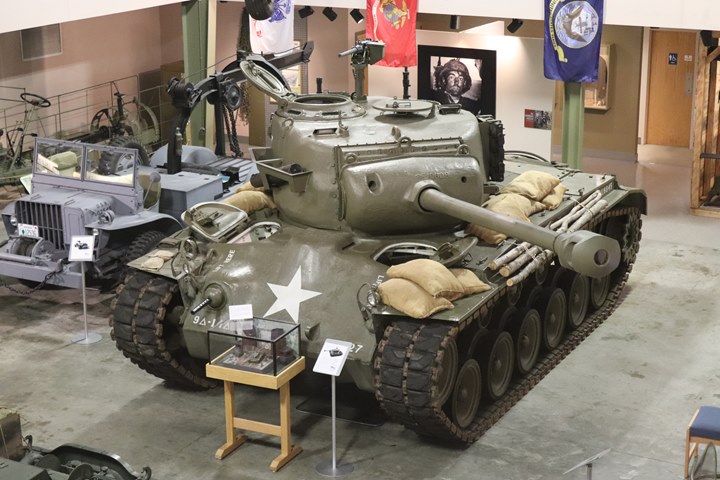
This Fisher Body Grand Blanc, MI-built T26E3 is serial number 35.
It is one of twenty T26E3s
that were shipped on an emergency basis to Europe before the tank had
been fully tested by the U.S. Army. Much of the testing was done
by the tankers that operated them in Europe. These twenty tanks were known as the "Zebra Mission."
This tank along with serial numbers 27, 28, and 39
participated in the taking of the Remagen Bridge in Germany on March 7,
1945. This tank would have been equipped with a Sherrill AEG-1 compass.
Author's photo.
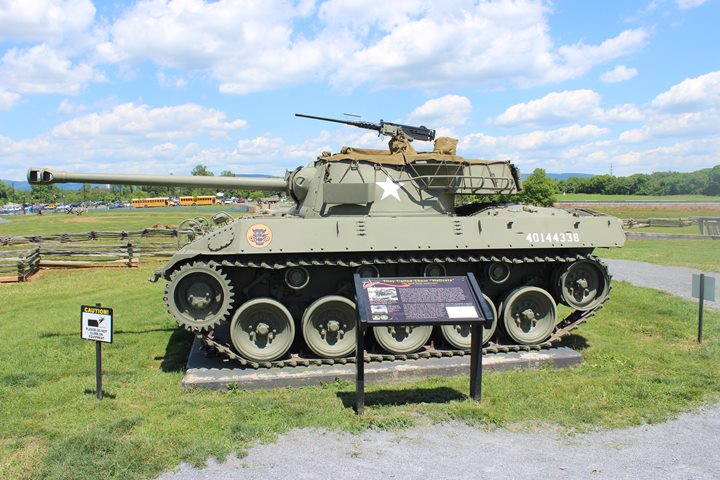
Buick-built M18 tank destroyers were introduced mid-war, about the same
time as the
Sherrill compasses. Author's photo.
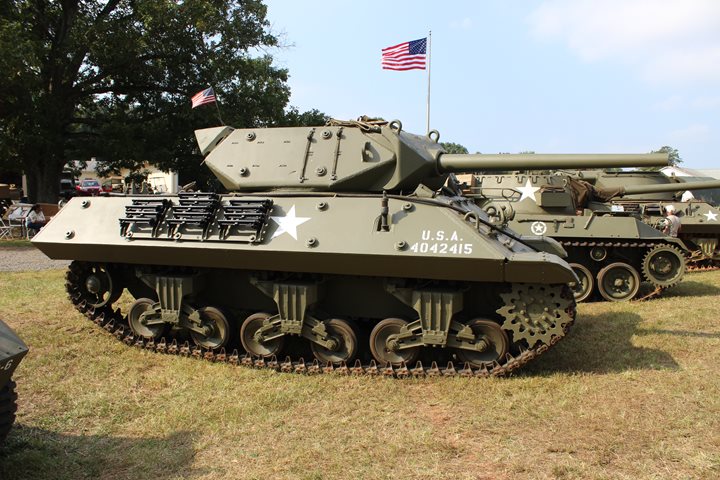
M10 tank destroyers were equipped with the Sherrill AEG-1 as they moved
across Europe towards Germany after D-Day. Author's photo.
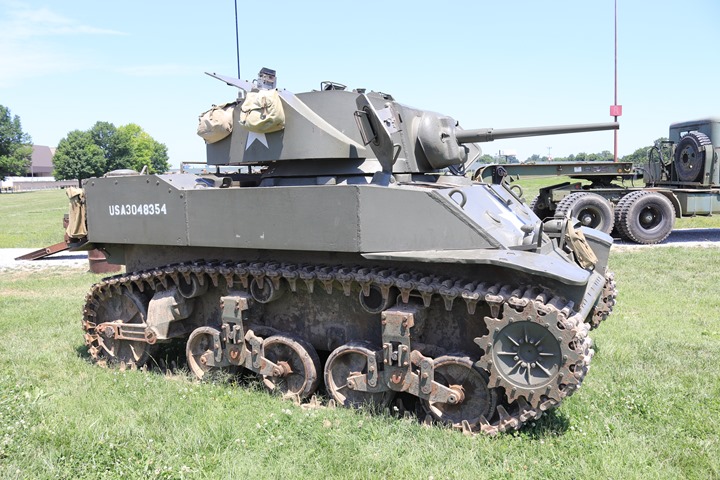
The installation of the AEG-1 into the M5A1
light tanks was extremely important. These tanks were used in the
scouting and reconnaissance mode in Europe. They operated out
ahead of the main forces probing enemy lines and defenses. They
needed to know where they were going, and just as importantly, how to get
back to friendly forces. Author's photo.
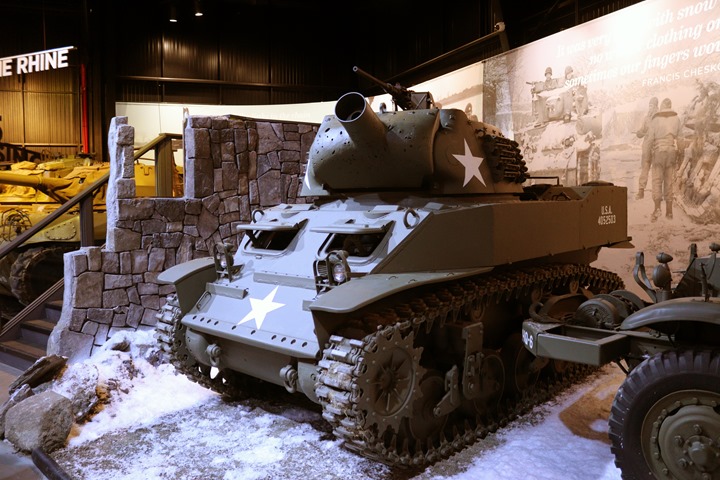
The M8 75mm Howitzer Gun Motor Carriage was
built on the same chassis as the M5 light tank. These provided
mobile artillery that could move with the infantry and set up quickly
for a fire mission. An accurate Sherrill magnetic compass assured they were set up and firing at the correct target.
Author's photo.
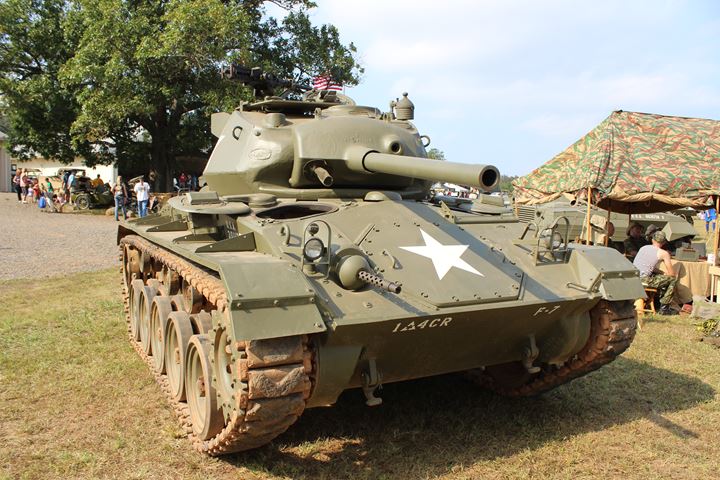
M24 Chaffee light tanks began replacing the
M5 series tanks as the war continued in Europe. They also then
served in the scouting role where the Sherrill AEG-1 was an important
asset to the mission. Author's photo.
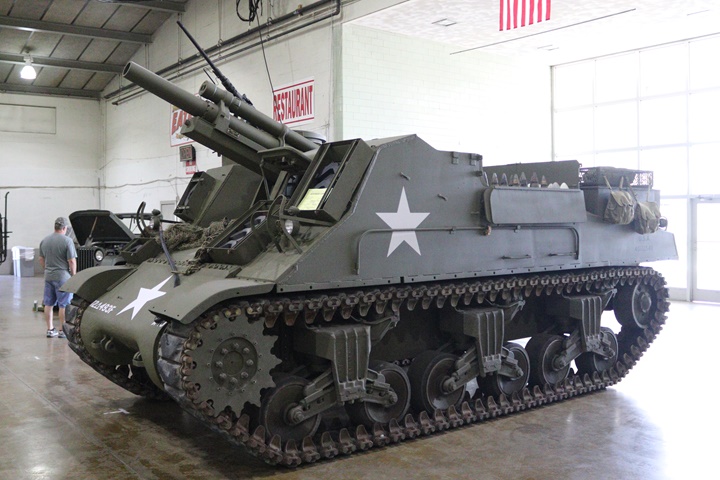
This 1944 Pressed Steel M7B1, serial number
758, was on display at the
2019 MVPA National Convention at York, PA. The following photos
show the high degree of restoration on this vehicle. Author's
photo.
M-6
-
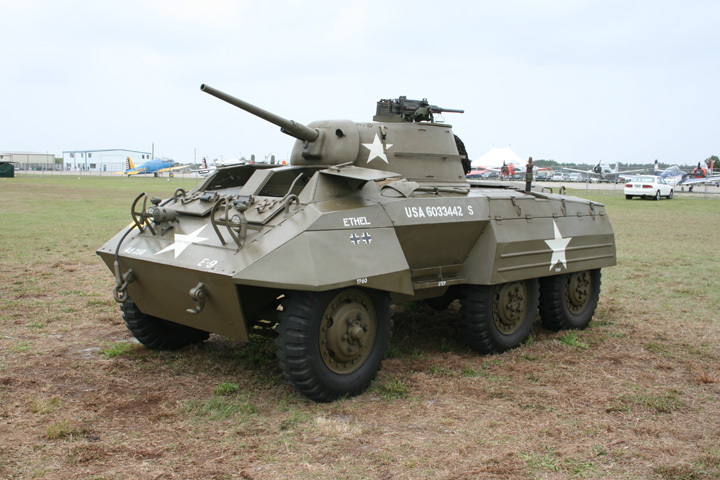
An M-8 armored car similar to this one visited the Sherrill Research
Corporation factory on November 24, 1944. These were also used in
the scouting mode where the Sherrill M-6 magnetic compass assisted to
assure it scouted the proper area and then returned safely to
friendly forces. Author's photo.
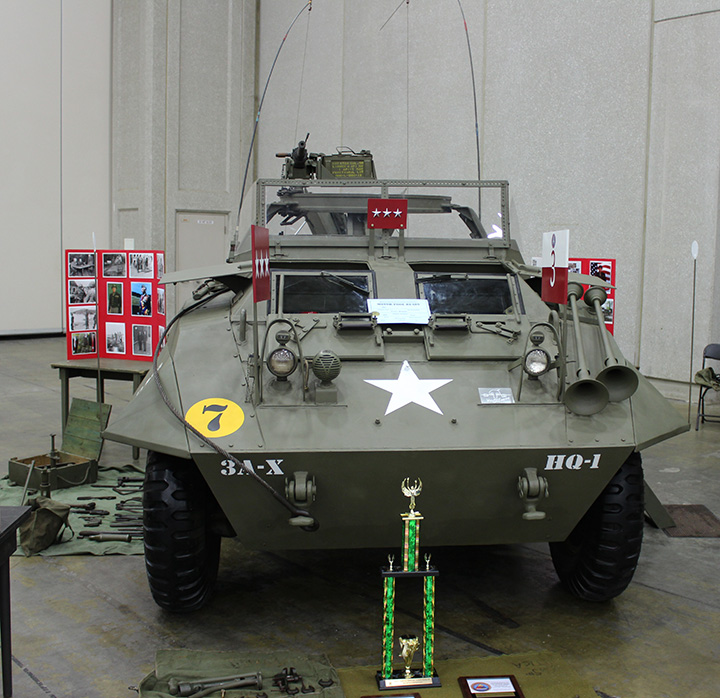
General Patton used an M20 for his command car when he was in Europe.
This is a re-creation of that vehicle. Author's photo.
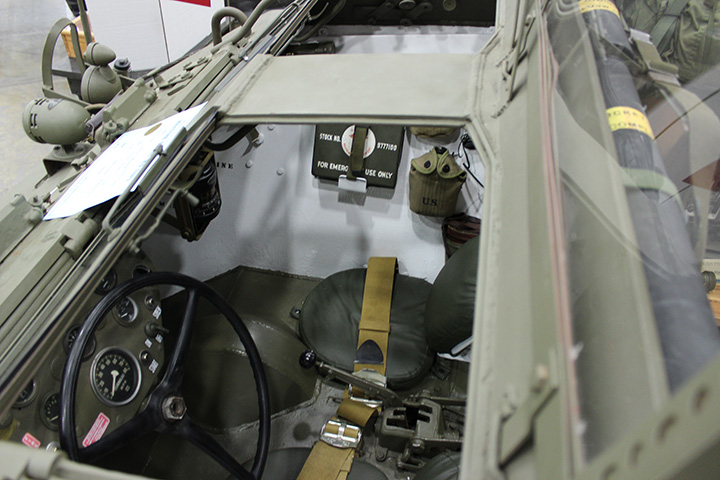
The Sherrill compass is mounted next to the steering wheel.
The assistant driver's job was to monitor the compass and inform the
driver of any needed directional changes. According to an article on
the restoration of this vehicle, the compass is an AEG-1.
Historical records indicate it should be the smaller M-6. However,
General Patton was very involved in the design of the several vehicles
he used as command cars and may have ordered the larger AEG-1
be installed. Author's photo.
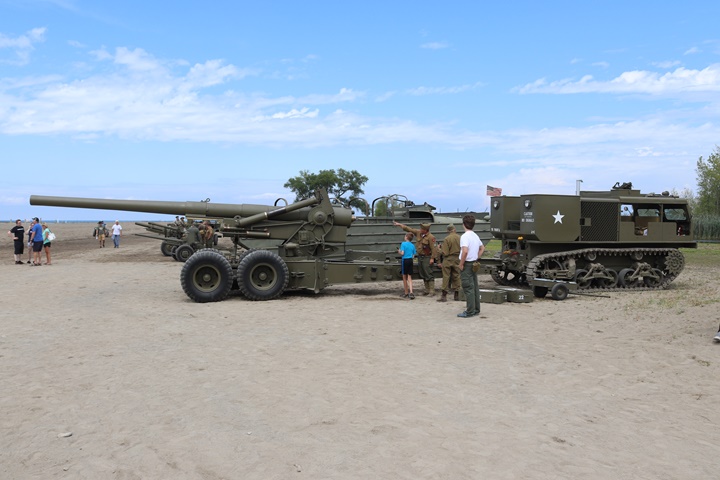
High speed tractors were utilized during
World War Two to tow artillery pieces. This M4 high speed tractor
has a 155mm Long Tom attached. A Sherrill M-6 magnetic compass
would have been used in the M4. Author's photo.
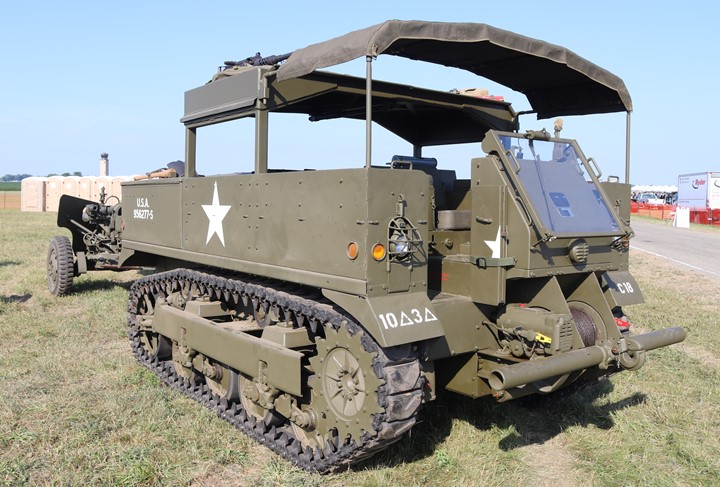
This
International Harvester M5 high speed tractor has a 105mm howitzer
attached. Because of the light armor on the vehicle, an M-6 was the
appropriate compass. Author's photo.
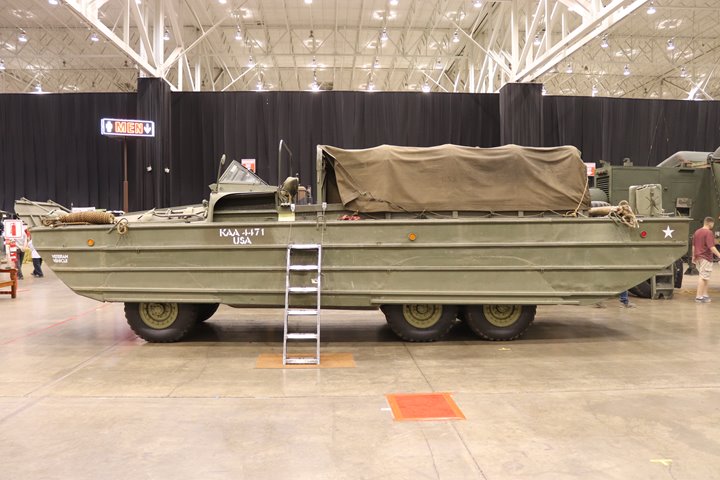
DUKW amphibious trucks were equipped with the
Sherrill M-6 compass. A properly working compass was very
important for the DUKW to assure it navigated to the proper beach during
an amphibious invasion. With a long cruise over open water,
landing craft many times landed on the wrong beach. A Sherrill
magnetic compass was instrumental in assuring this did not happen.
Author's photo.
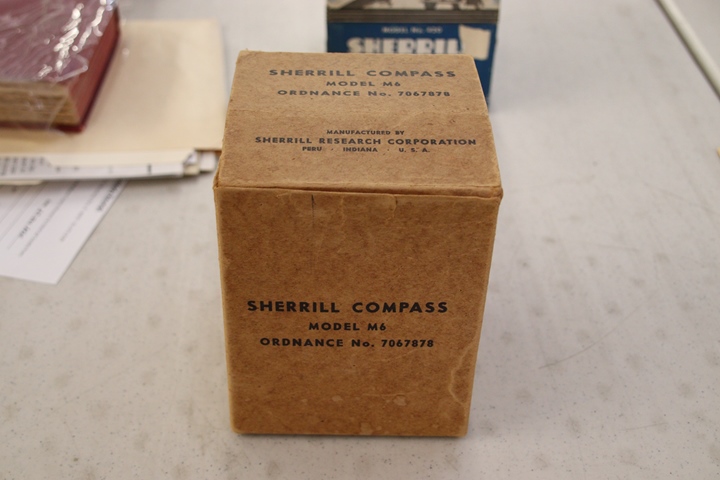
The M-6 came in this type of box with a copy of
the manual. Author's photo at the Miami County Historical Society.
Excerpts from the Sherrill Instruction Manual:
The first thing I did once I decided to publish a page on the Sherrill
Research Corporation was to purchase a manual. This one is for the
AEG, AEG-1 and M-6 magnetic compasses. It covered all three of the
Sherrill compasses used by the U.S. Army. Sherrill published a
second manual for the U.S. Navy for its No. 6 compass. This was the
equivalent to the M-6.
I have only included pages that show the
different parts of the compasses and any relevant information.
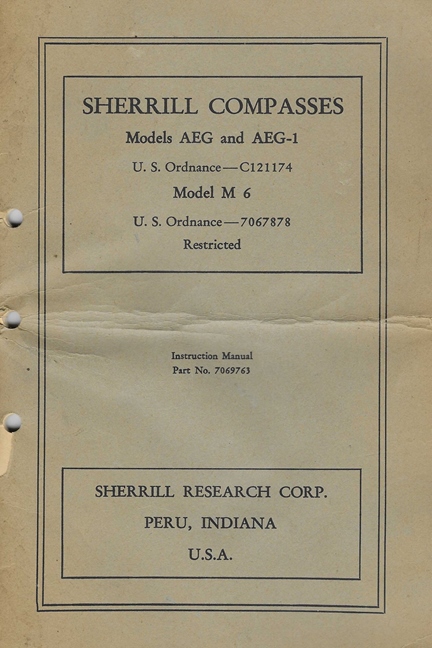
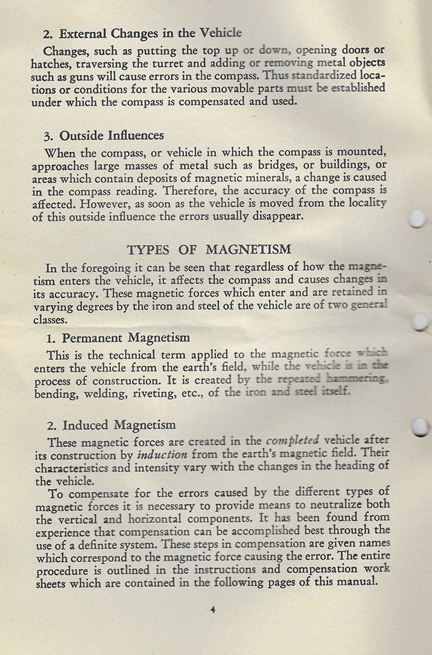
This page gives a basic overview of
magnetism.
AEG-1
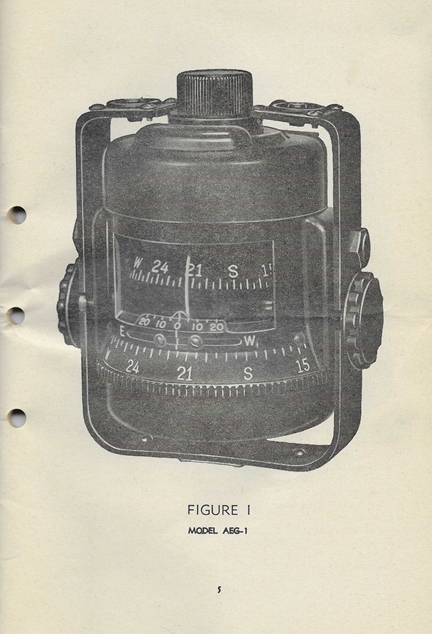
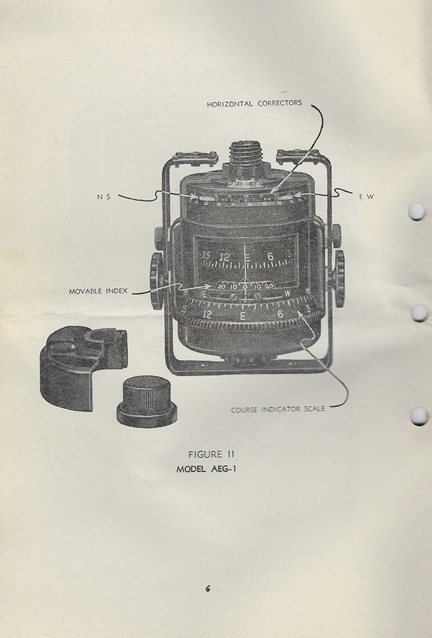
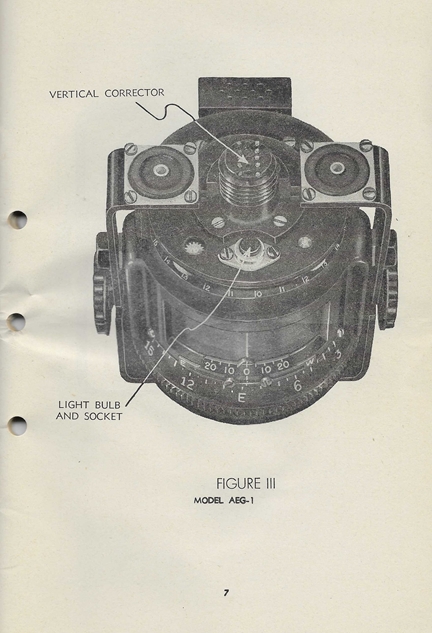
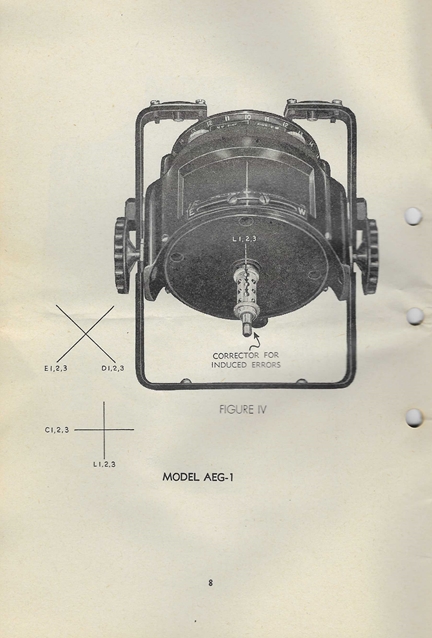
For all compasses
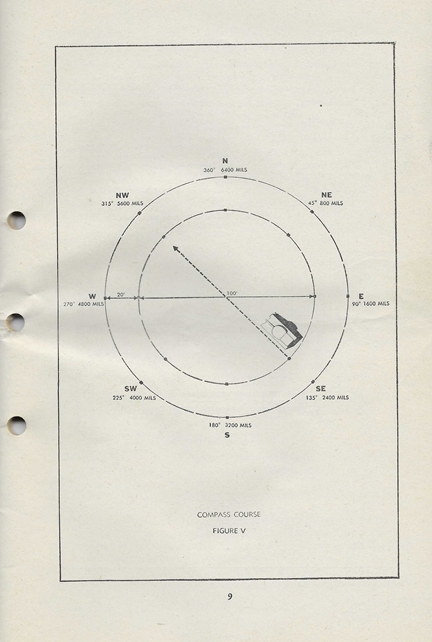
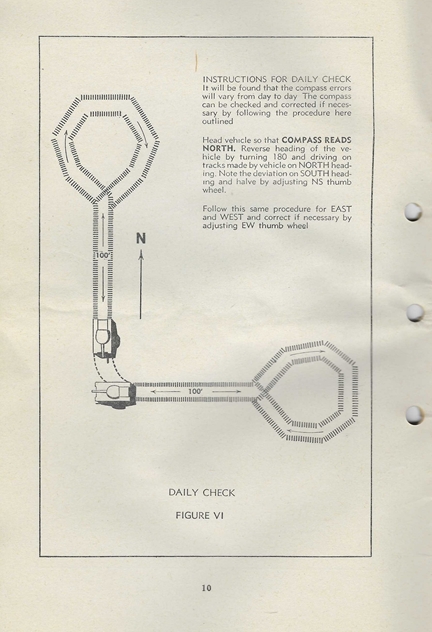
AEG
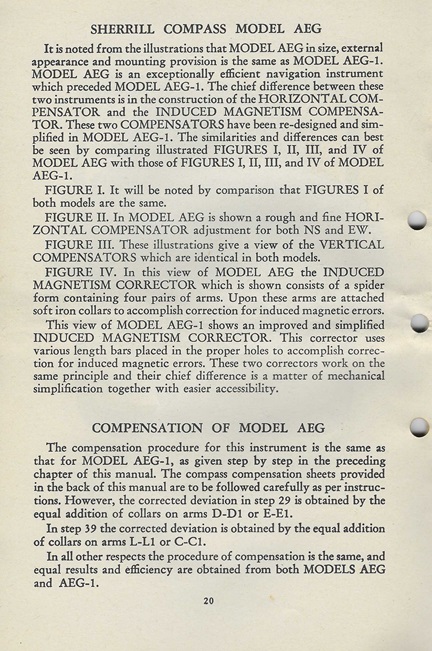
I have placed this page intentionally out of
order because it explains the different between the AEG and AEG-1.
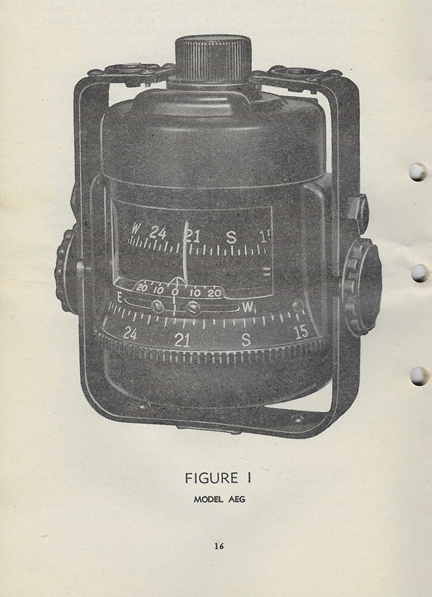
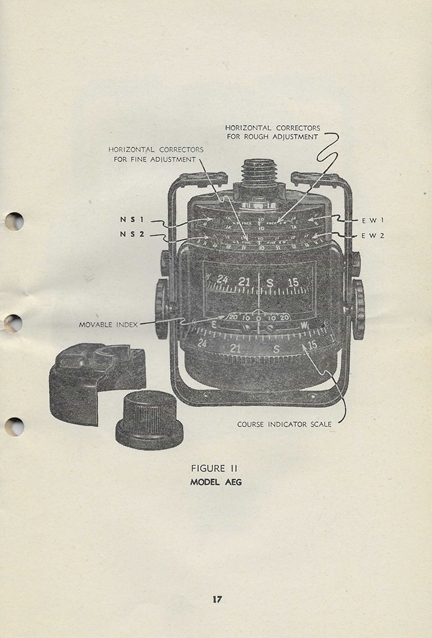
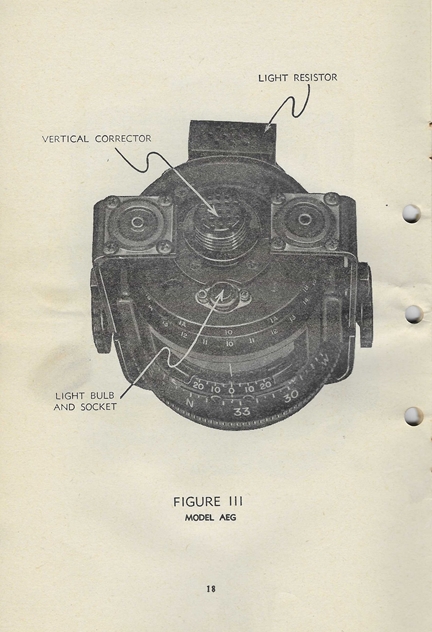
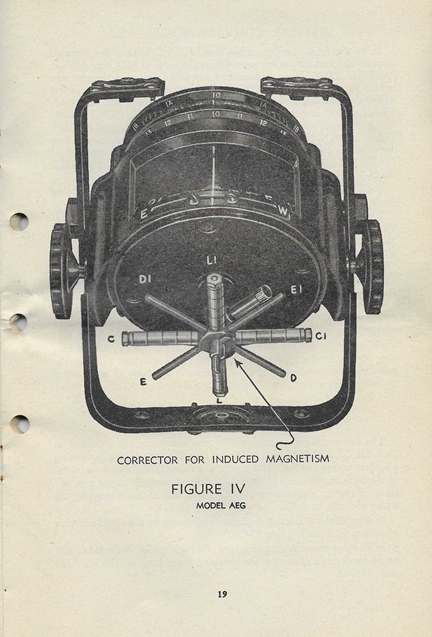
M-6
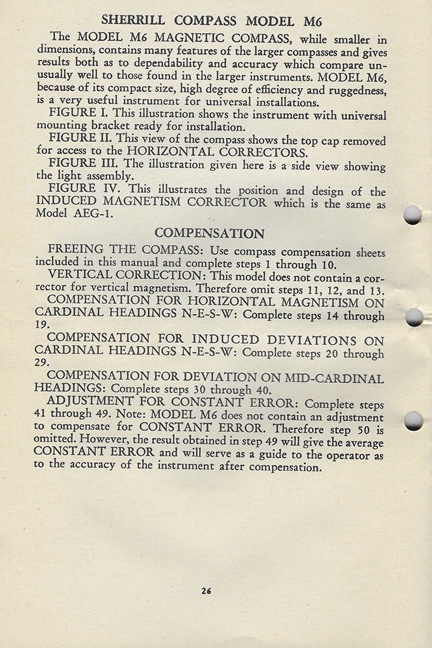
This page is also out of order, as it
contains a very brief explanation of the M-6.
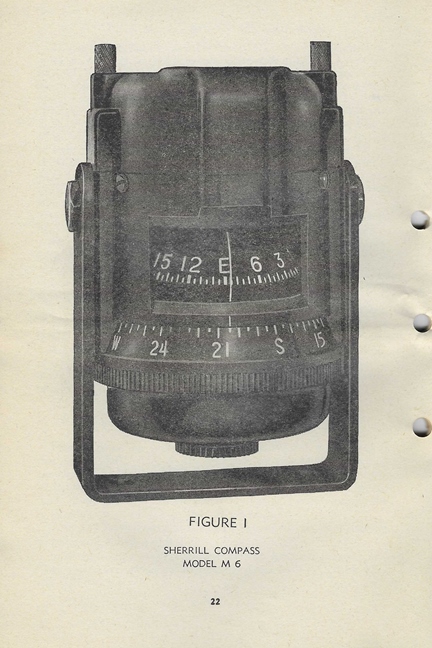
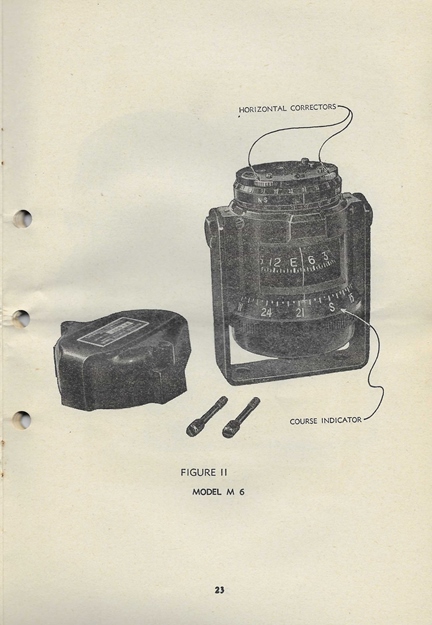
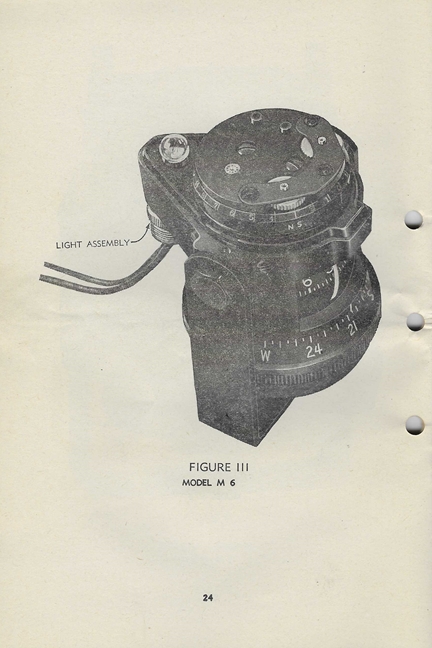
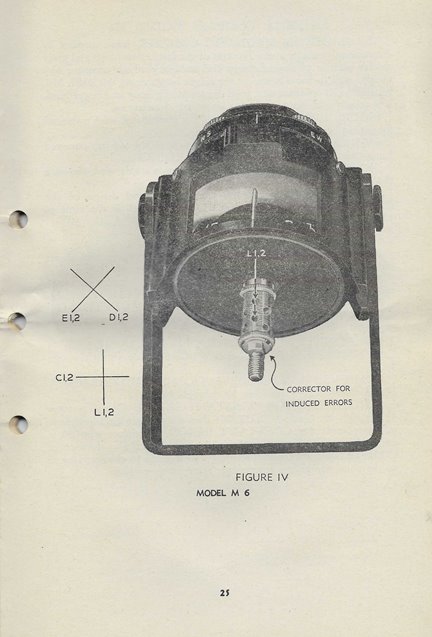
|


































































